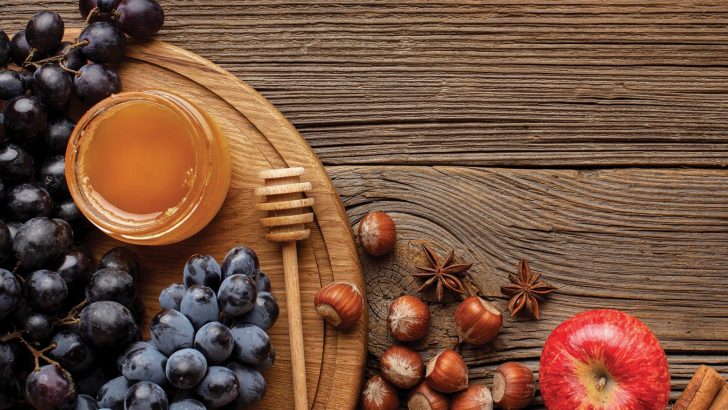Ruadhán Jones explains how to make the most of autumn fruits
Every self-respecting Irish recipe book has its own spin on apple tart. Some proclaim the wondrous effects of brown sugar, others call for no sugar at all! It’s an Irish staple and for good reason – Ireland has a climate ideally suited to autumn fruits like apples and blackberries.
This year’s blackberry season looks to be an especially good one as autumn arrived early, with cooler, wetter conditions setting in by mid-August. For apples, the growing season can continue into November, if we have an Indian summer that is.
The idea of cooking in-season is sometimes lost on us in a supermarket environment, where apples are available all year round. We were very fortunate growing up in that our granny had a few apple trees which we could plunder. As a result, autumn was a season of tarts and crumbles, to the point that my sister complained, “Not apple tart again”!
Over the years, we’ve branched out in our uses of apples, blackberries and even the astringent sloe, also known as blackthorn. Whether you have access to an orchard, a country lane, or are simply making the most of the autumn stock on supermarket shelves, here are a few of ideas for what you can do to make the most of the autumn fruits.
Delicious desserts
Apples are wonderful in desserts. They are sweet and juicy, but with a citrus edge that makes them very versatile. The basics for nearly all apple dishes are peeling, coring, chopping: these can be time consuming, but won’t distract you from your favourite show if you need some entertainment.
The place to start is with a baked apple. It’s simple to prepare, easy to cook and versatile with its filling. The best way to make them is cored and stuffed full of dried fruit, spices and brown sugar, a wholesome and filling dessert. But it’s so easy to adjust that any number of fillings could be invented.
The next level up, of course, is the humble apple crumble. The crispy, buttery topping is a mix of flour, butter and sugar and can be whipped up in no time. Chop up your apples and put them in a bowl with sugar suited to your taste – we often stew our apple first to save time in the oven, but if you like your apple with more crunch, you don’t need to. Mix the cold butter with the flour until it resembles moist breadcrumbs and sprinkle it over the top. Voila, you have your crumble!
Once you have the basics, apple tarts – or pies as they’re called in the States – are the next level up. A delicious, buttery French pastry ala Darina Allen’s tarte Tatin is the pinnacle of this dish, but it’s equally well served by a solid sweet pastry.
Once you have the basics, it’s an easy thing to spice it up to your taste. We have taken to adding a little almond flour to ours which gives it a beautiful, melt-in-your-mouth texture. There are a number of variations, and the internet is a treasure-trove, so go wild. Equally, chefs like Darina Allen and Nigella Lawson are always reliable for a good recipe.
Simple cider
Over the years, we’ve branched out in our use of apples. Because we got so many, it came to a point where they would sit in boxes in our attic, going to waste. One year, I came across a basic recipe for cider and decided to give it a go.
ve! We opened a bottle on Christmas Day and, not realising how much pressure it was under, let it gush out like champagne all over the floor. It was a learning curve and one of the first lessons was to use less pressurised bottles!
The recipe came from Darina Allen’s Forgotten Skills of Cooking. Roughly, the method was to first grate your apples into a stainless steel bowl before covering them with water. You cover the bowl and stir once a day, every day for a week. Then you strain out the largest bits and add sugar, ginger and cinnamon. You leave it to macerate for a day and then strain it through muslin – or a similarly fine material – to get rid of the must. Then you bottle it and leave it until Christmas, when you get a sweet and gingery cider.
While Ms Allen suggest using glass bottles tightly sealed, I would advise using plastic bottles to monitor the level of pressure. Equally, storing these in an outdoor shed is advisable so that if they do leak or the cap comes off, it won’t make a mess indoors. The cider will be alcoholic, so be wary when drinking it and don’t give it to children. Once you have the hang of it, it’s a very enjoyable process.
Jellies and jams
Autumn provides such a variety of fruits for jellies and jams. Picking blackberries is an excellent way to get kids involved in the great outdoors, with something tangible and tasty at the end. Blackberries litter the countryside and command much of the attention, but sloes and elderberries are also common and very versatile.
If you have leftover apples, they make a wonderful accompaniment and, particularly in the case of blackberry, a necessary one. Blackberries are short in pectin, necessary for binding the jelly when it’s setting, but the apples make up for the shortage and ensure a firm set.
If you’re just starting out with jam-making, blackberry and apple is a good one to begin with. It’s simple to make and the ingredients are readily accessible. As for equipment, the only essentials are a large, heavy based saucepan and a jelly-bag or tea towel for straining the juice from the fruit. That makes the difference between a jelly and a jam – the first has no bits, the second has.
Again, Darina Allen provides a number of excellent recipes in her book Forgotten Skills of Cooking which can set you on the road. In particular, I’d draw your attention to recipes for apple and elderberry jelly, and sloe jelly.
The elder tree has a long history in folklore, some say that it wards off evil, others that witches gather round them. The berry itself is small, round and red, and makes a light, sweet jam. It can also be used for syrups and cordials, being reputed to have a good effect on digestion.
Sloe gin
The sloe is a less pleasing looking berry, lacking a gloss and coming as it does from the thorny blackthorn tree. Equally, if you were to bite them, you find them an awfully bitter and practically inedible. But when combined with enough sugar, they make a tangy jam, beautiful on sponge cakes.
If you’re feeling more adventurous, sloe gin is a delicious winter drink which requires little effort to make. All you need is a little patience while the sloes steep in the gin.
The only ingredients are sloes, sugar and gin:
- 450g/1lb sloes
- 225g/8oz caster sugar
- 1 litre/1¾ pint gin
For the recipe, there are four simple steps.
1- Prick the skin of the sloes all over with a clean needle and put in a large jar which has been sterilised in boiling water.
2- Pour in the sugar and the gin, seal tightly and shake well.
3- Store in a cool, dark cupboard – so that it keeps its colour – and shake every other day for a week. Then shake once a week for at least two months.
4- Strain the sloe gin through muslin into a sterilised bottle and it’s ready to drink.
This being Pope Francis’ ‘Season of Creation’, it’s a good time to explore the variety of fruits on your doorstep. These ideas are only the merest glimpse of what can be done and I’d highly advise exploring cookbooks and the internet for further inspiration.


 Ruadhán Jones
Ruadhán Jones
